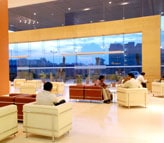
Cisco is well into its deployment of a highly redundant globalization center in Bangalore, India, where employees and customers are already enjoying the latest in IT and networking advances.
Initially, the primary intent of the Bangalore campus was to consolidate several Cisco offices scattered across the city, says Beata Mielcarek, Cisco IT program manager. Mielcarek was recruited from Boulder, Colorado, for an initial 3 month assignment to serve as IT process project manager for the Bangalore design. She later extended her stay to 18 months to program manage IT infrastructure implementation at the campus.
She explains that initially, the goal was to build a campus to consolidate Cisco India employees scattered across the city. That plan later changed when Cisco Executive Vice President and Chief Globalization Officer Wim Elfrink decided that given Bangalore’s status as a major economic and technology center, it made sense to build the campus into a full technical counterpart to the Cisco San Jose, California, headquarters. The Bangalore campus, a part of Cisco’s US$1.6 billion investment in India, today supports 1200 employees, operates three 16,000-square-foot engineering labs, one 17,000 square foot data center, and is slated to serve 10,000 workers by 2010.
As a technical peer to the San Jose facility, Bangalore runs an operations command center (OCC) that shares duty with San Jose’s OCC in 12-hour shifts to resolve high-priority network and IT problems. The campus also has been outfitted with full customer and executive briefing centers, making it more convenient for Asian visitors to attend technology demonstrations than traveling all the way to Cisco facilities in Europe, says Ravinder Pal Singh, Cisco project manager–IT in Bangalore.
At the Foundation
As of August, Cisco Bangalore hosts its own Internet point of presence (POP). The POP has improved network performance from Eastern locations, which previously had to connect into the San Jose POP before being routed to the Internet.
STM-4 (622 Mbps) primary and backup WAN and Internet connections “are enough to cater to 20 to 25 TelePresence rooms,” says Singh. Cisco TelePresence technology creates life-size and realistic group meetings between remote people and, for Cisco, “reduces overall travel between East and West,” he says.
A single-screen unit, the Cisco TelePresence 1000, supports small group meetings and requires 5 Mbps of bandwidth, according to Singh. The Cisco TelePresence 3000 three-screen unit, designed for larger groups, requires 15 Mbps.
Technology at Work: A Snapshot
As an Eastern technology counterpart to the San Jose headquarters, the Cisco Globalisation Centre East makes use of several emerging networking capabilities, says Ravinder Pal Singh, Cisco project manager, IT, Bangalore:
- Wireless LANs deliver campus mobility to employees and guests using Cisco Aironet 1100 Series 802.11g access points.
- Cisco MobileConnect fixed-mobile convergence technology extends local VoIP calls to Wi-Fi and cellular handsets to help decrease phone tag and increase productivity.
- Service-oriented data center technology, including virtualization, allocates server and storage space across shared equipment in the data center to make more efficient use of real estate and IT resources.
- Telepresence rooms bridge East and West employees and support local customer demonstrations.
- Cisco Connected Real Estate technology allows the IT network to controls facilities functions such as elevators, lights, surveillance cameras, and thermostats.
On the LAN, Gigabit Ethernet-to-the-desktop connections run over the latest Category 5e copper cabling, interconnected by Catalyst 6500 switches throughout the facility. By 2010, the campus will incorporate Category 6A copper cabling, a developing worldwide standard for Gigabit Ethernet that carries more stringent specifications for reducing crosstalk and system noise.
Heavy Emphasis on Redundancy
Strict business continuity requirements mean that the campus design contains redundant links, devices, power, telecommunications rooms, and network service providers. A triangular connectivity design among buildings means that “even if one half of the city is down, the campus will keep working,” Singh says.
In the WAN, there is a primary link to San Jose over an international leased line, with backup to Cisco’s Chennai, India, offices. Chennai links to Cisco sites in Singapore and Hong Kong, which each connect to San Jose over diverse routes.
“If the whole city of Bangalore is down, users can work by connecting through Singapore or Hong Kong, provided power and Internet are available in their homes,” says Singh.
Facing the Unexpected
The Bangalore project ran into a couple of challenges related to regulatory differences in India. For example, the site runs VoIP campuswide, but Cisco learned that Indian regulations don’t allow VoIP and public switched telephone network (PSTN) traffic to mingle on a single platform.
“If I’m talking to you on a PSTN line, I can’t conference in a VoIP line,” Singh explains. As a compromise, Cisco received permission well in advance of campus setup to partition the PSTN and VoIP calls on Cisco Unified Communications Manager switches to ensure that each voice session uses only one technology.
Cisco also discovered that it couldn’t redeploy equipment from the previous distributed Bangalore sites into the new campus, adding an unexpected expense, says Mielcarek. If a company wishes to avail itself of special tax credits for doing business at a particular location, a bonding regulation requires each piece of equipment to remain where it is initially deployed.
For More Information
Cisco on Cisco
Cisco IT Business of IT Case Studies
Cisco Globalisation Strategy